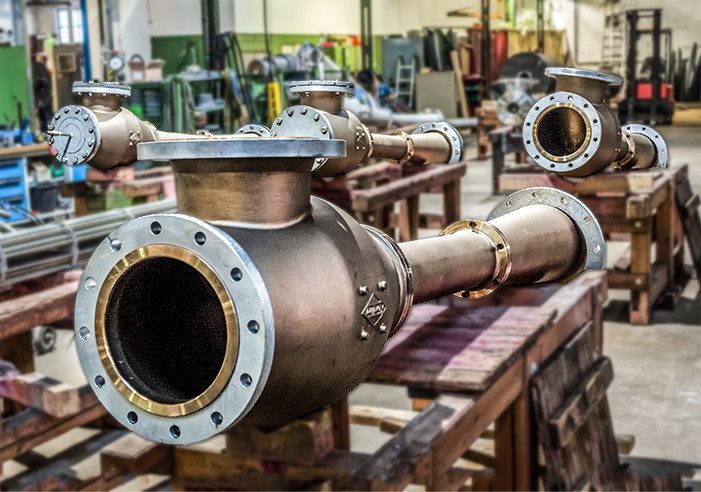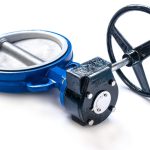What is meant by Eductor ?
Eductor is a simple type of pump which works on the ‘venturi effect’ to pump out air, gas or liquid from a specified area. Eductor require only a motive fluid or driving fluid for its operation, which allows it to use at any part of the ship including hazardous areas. When the driving fluid is passed through the eductor at the required capacity (which depends on the design of the eductor), a low pressure is created inside it. This low pressure or vacuum enables the eductor to suck liquid or gas from a certain area. This liquid or gas is pumped out through the driving fluid discharge.
Working Principle of Eductor on Ships
Eductor works on Bernoulli’s principle. It states that an increase in the speed of a fluid occurs simultaneously with a reduction in pressure. Refer to the simplified Bernoulli’s equation below for an in compressible flow.

Where,
v = Velocity of the fluid
p = Pressure of the fluid, and
ρ = Density of the fluid
From the equation it is clear that, when there is an increase in velocity, pressure is reduced and vice versa. In other words it is an equation for conservation of energy.
Now refer to the piping arrangement shown below.

The quantity (Q) of fluid flowing through the pipe is the product of area of cross section of the pipe (A) and velocity of the fluid (v); or,

Consider a constant flow of fluid in the pipe. The area of cross section at point 1 of the pipe is larger than compared to the area at point 2. Since the discharge quantity is same throughout the pipe, the velocity of the fluid increases at point 2 compared to the velocity at point 1. In other words,

Hence it is understood that because of the geometry of the pipe shown above, fluid velocity increases at point 2. According to Bernoulli’s principle, as fluid velocity increases pressure reduces. So we have,
As a result, we have a reduced pressure or vacuum at the point 2.
Operation of Eductor on Ships
The diagram below reveals parts of an eductor used on ships. Working principle is same as described above.

The driving fluid (normally seawater or air on ships) is allowed to pass through the nozzle(3) and diffuser(2) as shown in the figure. When the driving fluid achieves desired pressure and capacity, it starts taking suction through the suction side.
Normally valves will be connected to driving fluid inlet, discharge side and suction side of the eductor. To operate the eductor follow the procedure below.
· Open driving fluid inlet valve and discharge valve of the eductor.
· Start the driving fluid pump (normally fire pump) and regulate the pressure to obtain necessary capacity for the operation of the eductor. Driving pressure varies with the discharge head.
· Now open suction the valve for enabling eductor to take suction from the desired compartment.
· Never open suction valve before achieving desired capacity of driving fluid. It may cause back flow of driving fluid through suction.
· Similarly, before stopping, first close the suction valve before stopping driving fluid. (For the same reason stated above).
The design parameters of a normal bilge eductor used on ships are the following:
· Driving Fluid Pressure: 7 kg/cm2
· Driving Capacity: 20 m3/hr
· Suction Head: -7 mAq
· Suction Capacity: 5 m3/hr
· Discharge Head: 6 mAq
· Weight: 20 kg
Performance Curves for Eductor
From the suction flow capacity curve shown below it can be seen that, for the same discharge head, suction capacity varies with a changes in driving fluid pressure. For example, keeping discharge head as 6 mAq, suction capacity is 3 m3/hr and 5 m3/hr for driving pressures of 5 kg/cm2 and 7 kg/cm2 respectively. Increasing driving fluid pressure above designed pressure will not increase the design suction capacity. On the other hand, reduction of driving pressure below design pressure leads to reduction in suction capacity. Again, higher discharge head (or back pressure) results in reduced suction capacity.

Also, driving flow capacity curve shown below gives us the driving capacity for a particular driving pressure.

Maintenance and Troubleshooting of Eductor on Ships
Clogged Nozzle or Throat
The most common cause of trouble in the eductor is restriction of fluid flow in the nozzle or throat with foriegn particles. Particles lodged in the nozzle or throat can be removed with a soft material such as wood. Do not use hard or sharp materials as these can cause permanent damage to the eductor.
Low Driving Pressure
Driving fluid pressure below specified may result in loss of suction capacity or even back flow of fluid to the suction side.
High Back Pressure
Suction capacity will reduce drastically when the back pressure of driving fluid increases. This effect can be reduced by increasing the driving fluid capacity or pressure. So back pressure always to be monitored during operation of eductor.
Application of Eductor on Ships
· For creating vacuum in freshwater generator
· In vacuum toilet systems
· As self-priming system for centrifugal pumps
· Foam applicator in fire extinguishing system
· For pumping out water from bosun store, chain locker, etc.
· As a stripping system for framo ballast pumps



Comments are closed